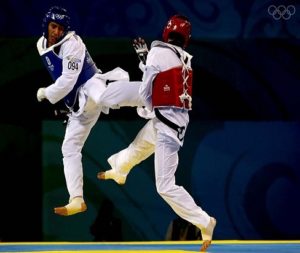
Taekwondo is a Korean martial art and Olympic sport that was developed in post World War 2 Korea by various martial artists but is usually attributed to military general and martial artist Choi Hong Hi. Taekwondo is based on the native Korean martial arts of Taekkyeon, Subak and Gwonbeop but also has significant elements of other martial arts such as Japanese Karate and to a lesser extent Chinese Kung Fu.
As a martial art, it is known as a style that focuses particularly on kicking, and experienced practitioners can be seen performing various spectacular head height and jumping kicks. There are various Taekwondo administration bodies but the main two are the ITF (International Taekwondo Federation) and the WTF (World Taekwondo Federation) but it is the latter that is the best known as it the WTF form of Taekwondo that has been a major part of the Olympic Games since 1988.
Object of Taekwondo
In Taekwondo competition, the object is to land kicks and punches upon the scoring zones of your opponent. These are the the torso and the head and both kicks and punches must be accurate and powerful, as light tapping kicks are not counted by scorers (or electronic scoring systems in major competitions). At the end of the three rounds of the match, the player with the most points is declared the winner, but the match can end early by one player knocking the other player out.
All Taekwondo practitioners, whether competitors or not are at all times expected to uphold the five tenets of Taekwondo. These are courtesy, integrity, perseverance, self-control and indomitable spirit.
Players & Equipment
In Taekwondo competition, fighters compete against other fighters of the same sex. They are also placed into weight categories to ensure that fights are as evenly matched as possible. In junior competitions, there may also be age categories too.
The white taekwondo uniform that competitors wear is often called a gi, but technically that is the Japanese name for a martial arts uniform and the proper Korean term is a dobok. A coloured belt is tied round the middle of the dobok and the colour signifies the grade of the practitioner. The belt system goes from white for beginners through to yellow, green, blue, red and then black for more experienced practitioners. Black belts then receive their ‘dan’ grades as they progress further in their experience and expertise. In a Taekwondo match, each competitor wears several pieces of protective equipment and these are:
- Head guard
- Chest (trunk) protector
- Groin guard
- Forearm guards
- Hand protectors
- Shin guards
- Mouth guard
Scoring
Scoring in a Taekwondo match is simple. A player gets:
- One point for a basic attack to the opponent’s torso
- Two points for a spinning kick to the opponent’s torso
- Three points for a kick to the head
In major competitions, electronic scoring systems are used that are placed within each player’s chest protector and are adjusted to take into account of the weight category of the fight. For head kicks (and fights where electronic scoring is not used), a panel of 4 judges push a button when they see a scoring point. When at least 3 judges agree, then a point is awarded.
Winning the Match
Once a Taekwondo match is over (at the end of the 3 x 2 minute rounds), the winner is the fighter that has the most points. If both fighters have the same amount of points, then an extra round is fought called the golden point round. In this round, the first fighter to score a point is declared the winner. Taekwondo matches can be won earlier if one fighter knocks the other out or if one fighter is disqualified for a rule breach.
Rules of Taekwondo
- Taekwondo matches should be contested by competitors of the same sex and in the same classified weight category.
- The competition area is a mat that measures 8 metres squared.
- Taekwondo matches are contested over 3 x 2 minute rounds with a rest of 1 minute between rounds.
- Each fighter attempts to knockout their opponent or score points by landing blows on their opponent’s torso or head. Kicks are allowed to both to the torso and head, whilst punches are only allowed to the body. Below the waist is not a permitted target.
- If a fighter and their coach think that a point has been missed or that a mistake has been made, they can make a protest. A video replay is then looked at by judges and a decision is made.
-
Fighters can lose points by the way of
penalties. These can be incurred by actions such
as:
- Punching to the face
- Attacking with the knee
- Attacking below the waist
- Stepping out of the ring with both feet
- Turning your back on your opponent
- Pushing, holding or grabbing your opponent
- Feigning injury
- The match is won by the fighter who knocks their opponent out or who has the greater number of points at the end of the three rounds.
- If the match is a draw, a golden point round is fought, with the fighter landing the first scoring point being declared the winner.









